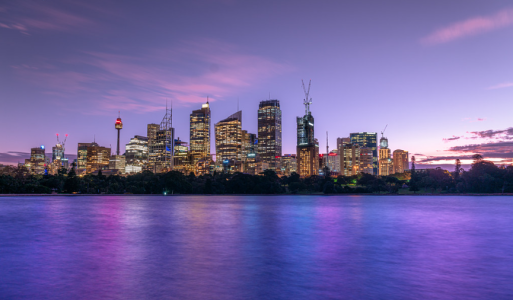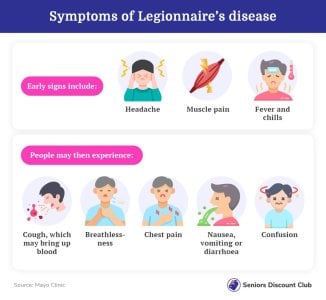URGENT ALERT: Thousands of Sydney NYE partygoers might have been exposed to a potentially deadly disease
By
VanessaC
- Replies 9
The festive season is a time of joy and celebration, but for some Sydney residents and visitors, it has brought an unexpected health scare.
Thousands of people who visited Sydney's Central Business District (CBD) over the Christmas and New Year period are being urged to stay alert for symptoms of Legionnaires' disease.
This comes after seven individuals were diagnosed with the potentially fatal lung illness, prompting a health alert from NSW Health.
Legionnaires' disease is a severe form of pneumonia caused by the Legionella bacteria.
It's not spread from person to person but rather through inhaling tiny water droplets from contaminated sources such as air conditioning cooling towers, hot tubs, and even soil or potting mix.
Symptoms can develop up to 10 days after exposure and include coughing, fever, shortness of breath, and headaches.
In severe cases, it can lead to life-threatening complications such as respiratory failure, kidney failure, and septic shock.
The disease is particularly dangerous for smokers, those with suppressed immune systems—such as chemotherapy patients—and those with underlying health and lung problems, as they are most at risk.
However, anyone can become infected, and early detection and treatment with antibiotics are crucial for recovery.
The Sydney Outbreak
The recent outbreak in Sydney has affected three women and four men, with ages ranging from 20s to 70s.
All were admitted to the hospital with pneumonia before being identified as carrying the Legionella bacteria.
The affected individuals are believed to have visited locations within Sydney's CBD, including Bathurst St, Sussex St, Elizabeth St, and Circular Quay, in the 10 days prior to their symptoms.
Given the thousands of people who flocked to the city centre for the holiday celebrations, the potential exposure is vast.
In response to the outbreak, NSW Health and the City of Sydney Council are inspecting cooling towers and reviewing maintenance records to identify further towers for inspection.
'Managers of buildings with cooling towers are being contacted and informed of the cluster. Building owners should ensure that their cooling towers are operated and maintained in compliance with regulation,' the NSW Health said.
'Public health units in local health districts across NSW follow up cases of Legionnaires' disease and work closely with local councils in the management of cooling towers.'
'Routine monthly testing of cooling towers allows the early identification of contaminated towers and allows for prompt additional cleaning and corrective actions.'
If you visited Sydney's CBD over the Christmas and New Year period, it's important to monitor for symptoms of Legionnaires' disease.
If you experience the following symptoms, seek medical attention immediately.
While the disease cannot be spread from person to person, it's crucial to inform your doctor if you've been in the affected area, as this can aid in early diagnosis and treatment.
Furthermore, while the current focus is on managing the outbreak and treating those affected, it's also a stark reminder of the importance of prevention.
Regular maintenance and cleaning of water systems, particularly cooling towers, are crucial in preventing the growth and spread of Legionella bacteria.
For individuals, quitting smoking can reduce the risk of contracting the disease, as it damages the lungs and makes them more susceptible to infection.

Did you or anyone you know celebrate the holidays in Sydney? Share this article with them and let us know your thoughts on this story in the comments below.
Thousands of people who visited Sydney's Central Business District (CBD) over the Christmas and New Year period are being urged to stay alert for symptoms of Legionnaires' disease.
This comes after seven individuals were diagnosed with the potentially fatal lung illness, prompting a health alert from NSW Health.
Legionnaires' disease is a severe form of pneumonia caused by the Legionella bacteria.
It's not spread from person to person but rather through inhaling tiny water droplets from contaminated sources such as air conditioning cooling towers, hot tubs, and even soil or potting mix.
Symptoms can develop up to 10 days after exposure and include coughing, fever, shortness of breath, and headaches.
In severe cases, it can lead to life-threatening complications such as respiratory failure, kidney failure, and septic shock.
The disease is particularly dangerous for smokers, those with suppressed immune systems—such as chemotherapy patients—and those with underlying health and lung problems, as they are most at risk.
However, anyone can become infected, and early detection and treatment with antibiotics are crucial for recovery.
The Sydney Outbreak
The recent outbreak in Sydney has affected three women and four men, with ages ranging from 20s to 70s.
All were admitted to the hospital with pneumonia before being identified as carrying the Legionella bacteria.
The affected individuals are believed to have visited locations within Sydney's CBD, including Bathurst St, Sussex St, Elizabeth St, and Circular Quay, in the 10 days prior to their symptoms.
Given the thousands of people who flocked to the city centre for the holiday celebrations, the potential exposure is vast.
In response to the outbreak, NSW Health and the City of Sydney Council are inspecting cooling towers and reviewing maintenance records to identify further towers for inspection.
'Managers of buildings with cooling towers are being contacted and informed of the cluster. Building owners should ensure that their cooling towers are operated and maintained in compliance with regulation,' the NSW Health said.
'Public health units in local health districts across NSW follow up cases of Legionnaires' disease and work closely with local councils in the management of cooling towers.'
'Routine monthly testing of cooling towers allows the early identification of contaminated towers and allows for prompt additional cleaning and corrective actions.'
If you visited Sydney's CBD over the Christmas and New Year period, it's important to monitor for symptoms of Legionnaires' disease.
If you experience the following symptoms, seek medical attention immediately.
While the disease cannot be spread from person to person, it's crucial to inform your doctor if you've been in the affected area, as this can aid in early diagnosis and treatment.
Furthermore, while the current focus is on managing the outbreak and treating those affected, it's also a stark reminder of the importance of prevention.
Regular maintenance and cleaning of water systems, particularly cooling towers, are crucial in preventing the growth and spread of Legionella bacteria.
For individuals, quitting smoking can reduce the risk of contracting the disease, as it damages the lungs and makes them more susceptible to infection.
Key Takeaways
- There has been an outbreak of Legionnaires' disease in Sydney CBD following the Christmas and New Year period.
- Seven people were hospitalised with pneumonia before being diagnosed with Legionnaires' disease, prompting NSW Health to issue a health alert.
- People who visited the Sydney CBD since Christmas Eve are urged to be vigilant for symptoms such as coughing, fever, shortness of breath, and headaches.
- NSW Health is inspecting cooling towers and conducting reviews of maintenance records, urging building owners to ensure compliance with regulations to prevent further cases.
Did you or anyone you know celebrate the holidays in Sydney? Share this article with them and let us know your thoughts on this story in the comments below.









